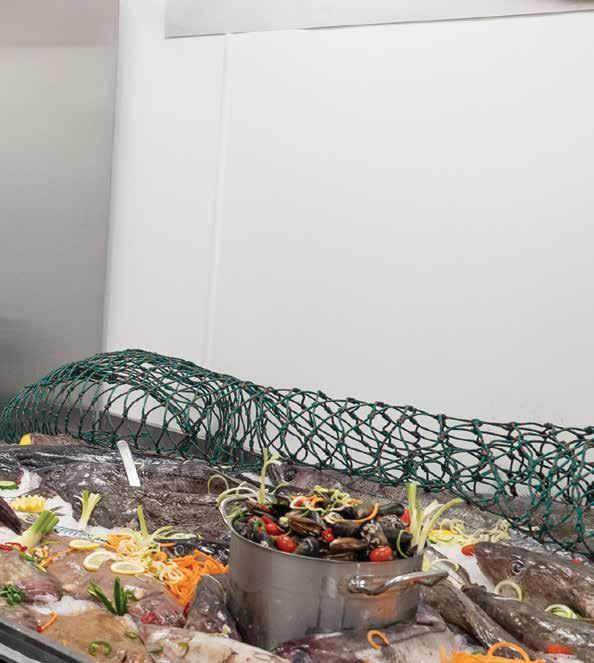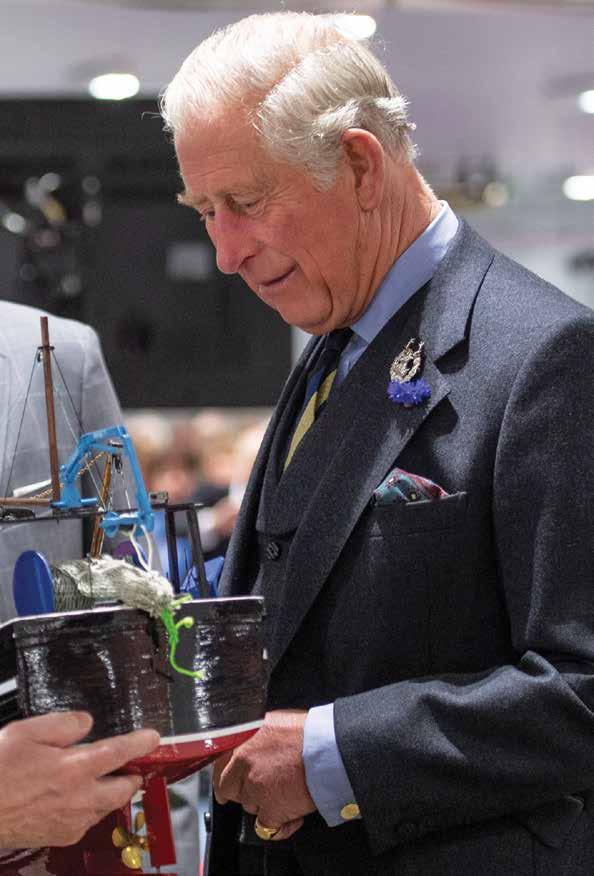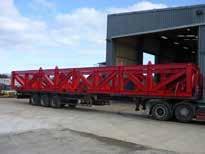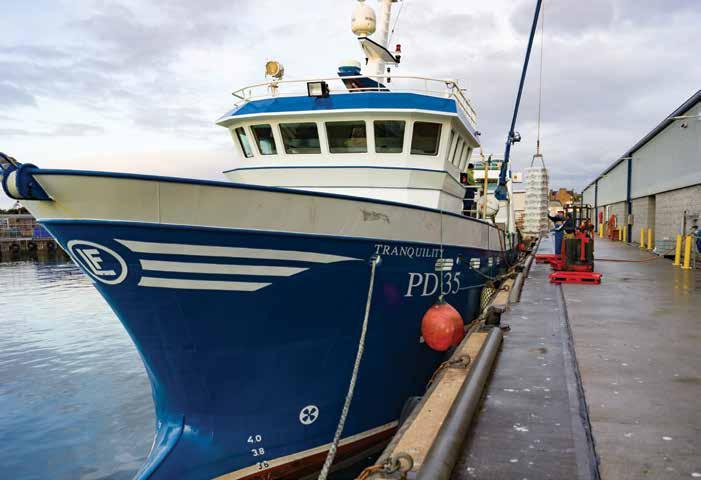
17 minute read
Investment with impact
from Port of Peterhead
by andybullen1
A fully integrated fishing hub is at the heart of
Peterhead Port Authority’s recent £51 million investment project. Investment with impact
Advertisement
Confidence and ambition – these were the drivers behind Peterhead Port Authority’s decision in 2016 to embark on a £51 million development, its largest ever investment and one that has transformed the port, putting in place the building blocks for an even more successful future.
Within this massive investment, the new £9 million fish market was opened at Alexandra Basin in 2018. At the heart of a fully integrated fishing hub, the market inevitably took most of the headlines – but the expansion has also been vital for the Port’s activities across offshore oil & gas, decommissioning and renewable energy.
The major package of works, which started in 2016, included: l Construction of a new fish market with 80% more floor space, with covered landing canopies for vessels discharging privately sold fish. l Dredging of the inner harbour to increase depth from 3.5 metres to 6.5 metres, which means that all current fishing vessels can now land fish at any stage of the tide. l Strengthening of surrounding quaysides. l Widening of the inner harbour entrance from 10.5 metres to 16.5 metres and also lengthening the lift bridge, Queenie Bridge, to improve access to and navigation in the inner harbour. l Removing the old fish market at Merchants Quay and dredging the berth to 7.5 metres to create a 180-metre deepwater and sheltered quay for commercial use. l Using the dredged material from the inner harbour for land reclamation at Smith Quay – tripling the space available to 48,000 square metres and creating a huge working area for NorSea.
The project was granted £4.4 million of funding from the European Maritime and Fisheries Fund and the Scottish Government.
The architects for the fish market were Arch Henderson and the main contractor was Chap Construction. The engineers for the harbour works were the RPS Group and McLaughlin and Harvey/ Boskalis formed a joint venture as the main contractor.
The sheltered waters of Peterhead Harbour.


Development Challenges
How does a port continue to operate in the midst of major development work? That was the challenge for Peterhead, as the new fish market and major harbour developments took place during 2017 and 2018. “It was a big challenge running the port and doing a development of that size”, says Harbour Master John Forman. “Fish landings were at their highest ever levels, but we were successful in keeping vessel and market operations going smoothly.
“Our marine staff were very busy in the control tower, especially as they had to co-ordinate the movement of barges dredging and moving material to the reclamation area. When we finished one part of the project and tided up, we then started on the next. For example, we knocked down the old fish market almost immediately after moving out and flattened the site as quickly as possible to prepare it for NorSea”.
Now that the major development is complete, the harbour maintenance and marine teams are focusing on routine maintenance and upgrading work. “There is always fendering to replace, painting to be done and other work to keep the port in top quality condition”, says Forman.
The last auction in the old fish market was held on a Friday; the first sales in the new market were on the Monday. “Everything was moved from one to the other over the weekend, mostly by our own Peterhead Port Authority staff”, he says. “The market was operating from June and officially opened by Prince Charles in September 2018”.
In another extraordinary logistical achievement, the new fish market was used for the opening ceremony, which took place at the same time as the town’s Fish Festival. The market was cleaned and washed down after the Friday auction and set up with carpets, tables and chairs for an opening ceremony held between 10am and 3pm on Saturday.
Some 500 guests enjoyed a threecourse meal at which different types of fish were served.
By 7pm on the Saturday, the market was cleared again, and it was washed down ready to receive fish landings again from noon on Sunday.
As Forman says: “People couldn’t believe that we could turn the fish market into a dining area so quickly – and back again”. In another extraordinary logistical achievement, the new fish market was used for the opening ceremony, which took place at the same time as the town’s Fish Festival
Quality and choice: The UK’s top fish market
Peterhead is handling record volumes of fish at its brand new, state-of-the-art fish market

Peterhead is the UK’s biggest white fish and pelagic port – and it is clearly set for further growth. The port has embarked on an exciting new chapter, based around: l Massive investment in a state-of-theart fish market l A reputation for quality and choice l A robust system that works like clockwork l A series of prestigious certifications for quality and sustainability The statistics speak for themselves. Peterhead has been handling record volumes of fish over the quaysides and in the fish market, with sales of white fish, pelagic fish and shellfish exceeding £200 million a year.
Fish landings and fish sales at Peterhead represent the central cog in a large and thriving industry which includes fish processing, adding value, refrigeration and storage, logistics and transportation.
It is all about confidence: the vessels know they can land and sell the fish, and the buyers know they can buy the fish they need.
“The potential going forward is huge”, says Peterhead Port Authority Head of Fishing – Commercial Peter Duncan. “As a port, we do whatever we can to facilitate business growth. The big ‘plus’ from the new fish market is space. We have capacity, so whenever a vessel comes in, its owners know that the fish will be landed and go to auction.
“That, in turn, brings in more and more buyers. That increases demand – which, in tandem with the high quality we are renowned for, means higher prices. That in turn means more fish are landed. Because of our size, we are attracting

more fish, higher prices and more buyers. A strong market brings benefits and advantages throughout the supply chain. And the quality is exceptional”.
The business development/customer relationship focus is on ensuring that every stakeholder using the port is getting what they need from the port and that there is fairness across the board, explains Duncan. “That means fishermen, sellers, buyers and everyone in the fishing cycle. We meet with them all regularly, to ensure any issues are addressed promptly”.
Peterhead’s strengths as a fishing hub are based on its history and location, he says. “Peterhead’s tradition as a fishing port goes back to the 1400s, and the Port of Peterhead was officially established in the 1500s. The port has always had the benefit of a sheltered position on the north-east coast. Its breakwater was built to establish the port as a place of refuge that never closed. That is a definite strength. And then there is the shared experience in and around the town – you just can’t beat experience”.
Five days a week, Peterhead’s vibrant fish market attracts the most demanding of buyers, confident of consistent and unrivalled variety, quality and quantity.
Within Peterhead, the fishing industry includes primary and secondary processing, smoking, storage, freezing, transport, imports and exports. And this is not just about what’s on the lunch table or in the fish restaurant. The sale and use of fish goes beyond human food to include products for pharmaceuticals, cosmetics, fish meal, fertiliser and pet foods.
Peterhead also provides a wide range of support services, including fishing net manufacturers and menders, ice making operations, trawler management, fish selling agents, ship repair services, ships’ carpenters, painters, electricians and engineering companies.
A fishy introduction for the Prince of Wales.

Covid-19
The Covid-19 pandemic inevitably had a major impact on operations at Peterhead Fish Market.
In March 2020, PPA acted swiftly, introducing a range of measures which allowed the fish market to carry on operations, while also observing social distancing requirements. Initially, daily market capacity was reduced to 5,000 boxes of fish, to allow at least three metres distance between each row of fish at auction. Space was strictly allocated to each vessel.
Three months later, the capacity was somewhat increased in line with Scottish Government advice.
Restrictions and procedures are kept under constant review as advice and guidance from the Scottish Government changes.
Other Covid-19 requirements include the introduction of one-way systems, adjusted timings to ensure that sales are finished and processors have left the building before the transport and labour force arrives, frequent handwashing and hygiene measures for all, and face coverings in enclosed public spaces.
The social distancing measures put in place along with the use of extended open walkways between each tier of fish has allowed each individual the space to physically distance in the auction room, explains Peter Duncan. “This was a crucial factor that allowed the fish market to remain operational”.
Restrictions and procedures are kept under constant review as advice and guidance from the Scottish Government changes.
PPA will take ‘careful, gradual and incremental’ steps in making the changes needed to return to full capacity.
Peterhead Fish Market already had the highest possible hygiene and ethical standards for a fish storage facility, and the processes and procedures that were put in place long before the Covid-19 outbreak have been invaluable in ensuring that the market remains operational and hygienic.

Seafood Processing Hub
Peterhead Port Authority has plans to refurbish a block of processing units it owns next to the fish market. These are rented out to smaller companies.
“There is a place for small as well as big companies”, says Stephen Paterson. “We need the mix for a successful market. Not every processor aspires to be an international brand – they might just serve the local market. There are family-run companies in this sector that are supplying fish and chip outlets and restaurants locally. The industry is healthier with all of them”.
On the Menu White Fish
l Mainly haddock, cod, whiting, flatfish, monkfish, coley l Vessels of 25-30 metres in length l Landed at Peterhead from as far away as Grimsby, Shetland, Denmark and the Faroes l White fish selling agents at Peterhead Fish Market: Don Fishing Co Ltd P&J Johnstone Ltd
Pelagic Fish
l Mackerel, herring, blue whiting, capelin, sprats, horse mackerel l Larger vessels, typically 75-80 metres in length l Landed at Peterhead from Shetland, Norway, the Faroes, Iceland, Poland, Denmark, Sweden and Ireland l Seasonal – January, June/July and October l Pelagic companies at Peterhead: Denholm Seafoods Ltd NorthBay Pelagic Ltd Lunar
The Stats
Fish and shellfish landed: 153,000 tonnes Value: £210 million
Pelagic fish landed: 83,000 tonnes Value: £68 million
White fish landed: 64,000 tonnes Value: £127 million
Port of the Year...
Peterhead was named Fishing Port of the Year at the annual Fishing News Awards in May 2019.
Fish of the Year...
Among recent landings at the market was a 94 kilogram halibut.

Market Day
The sale of a £130 box of cod marked the very first sale at Peterhead’s new fish market in June 2018. Three months later, the market was officially opened by Prince Charles.
“We were delighted and honoured to have Prince Charles in Peterhead to open the market”, says Peterhead Port Authority CEO Simon Brebner.
The investment in the market totalled around £9 million, while the harbour upgrade works cost £42 million. The entire development was welcomed by local councillors as ‘a real vote of confidence in the town and in the future of its industry’.
The new market has capacity for 10,000 boxes, a substantial increase on the 7,000-box capacity in the old market at Merchants Quay, and it is equipped with the latest refrigeration and computer technology.
The design of the market provides good access for boats on the quayside and for articulated lorries on the shoreside; this enables the swift, efficient and hygienic movement of fish through the landing, auction and loadout process. For

example, a fishing boats could come into port at 3am, land its catch and be back out at sea by 6am, to start fishing again.
The market upgrade created larger walkways for pallets, trucks and forklifts, and also provided plenty of office space and a new café. Crucially, more floor space also means that the fish can be better displayed, with less stacking of boxes. This has been a huge advantage in allowing for social distancing during the Covid-19 crisis.
Staff in the fish market work three shifts to cover 24 hours. Information about the fish coming into the market is displayed online overnight and continually updated so that buyers can monitor the website and make their purchasing decisions depending on what they require. The market floors are regularly swabbed and checked. Temperature is computer controlled and constantly monitored.
“There is nothing we don’t do to make sure we are the best”, says Peterhead Port Authority Operation and Compliance Manager Allison Sherrington.
TV Stars
Fish Town, the BBC documentary series, shone a new spotlight on Peterhead, the UK’s biggest fishing port. To quote the BBC, the programme focused on the ‘the extraordinary people working on land and at sea to put the fish on our plates’. Fish Town told the behind-the-scenes story – of the hard work, dedication, expertise and unrelenting focus on quality that underpins Peterhead’s success.
The BBC also created a few celebrities along the way – not least Peterhead Port Authority Operation and Compliance Manager Allison Sherrington.
The fish market has become a visitor attraction in its own right, although there are obviously restrictions in place during the Covid-19 pandemic. As well as attracting a steady stream of high-profile visitors, including politicians, the market has become a popular destination for school outings and numerous clubs and societies. “We have had many school visits to the new fish market – so we are telling the story to the next generation”, says Allison Sherrington. “We have had numerous visits from groups such as Rotary Clubs and we have had a lot of television coverage – and all of this is enhancing our reputation as a leading fishing port. It is publicity which is great for the port”.
Peterhead is recognised as a ‘centre of excellence’ for the fishing industry. Those on the outside may not grasp the true extent of activity. Providing the facilities to land catches is just the start.
This centre of excellence also includes: l The facilities and expertise for repairing nets. l Facilities for maintaining and repairing vessels. l A state-of-the-art Shiplift handling vessels of up to 2,000 tonnes. l A covered repair hall for yearround working, accommodating vessels up to 47 metres long and 25 metres high. l A four-berth slipway for vessels with a keel length of up to 27.4 metres and beam of 7.2 metres, and a drydock for vessels up to 57.9 metres long and 10.6 metres wide, with maximum draft of 4.5 metres. l A cluster of painters, engineers and boat repair experts.


The Market Leader in SURFACE PREPARATION & PROTECTIVE COATINGS
We are a family run surface preparation and protective coatings company. DBS offer a superior quality finish enhancing your assets longevity and reducing maintenance downtime and costs. DBS prides itself on getting the job right first time, delivered on time and within the customer's budget. Coating packages can be tailored to suit any environmental climate, all of which is backed by our surface preparation and coating integrity testing undertaken by our in house NACE qualified inspector.
DAVIDSONS BLAST SERVICES LTD
Site 9 & 9A | Dales Industrial Estate | Peterhead | AB42 3JF T: 01779 470518 E: info@davidsonsblastservices.co.uk WWW.DAVIDSONSBLASTSERVICES.CO.UK
Davidsons Marine & Industrial Painters
Services provided • Hydrojetting Specialists • Grit Blasting • Hot Zinc Spraying • High Pressure Cleaning • Foam Injection Insulation • Fish room Refurbishment • Specialist plastic coatings • Specialist floor/deck coating systems Facilities and locations • Covered shiplift for vessels up to 40metres • Peterhead, Fraserburgh and Macduff
Seagate, Peterhead AB42 1JP Telephone 01779 474455 Mobile 07831512384 Email davidsonspaintersltd@outlook.com www.davisons-ships-painters.co.uk

Quality Certification
There is increasing demand for full traceability of the fish from sea to plate and Peterhead has responded quickly and proactively. The new fish market quickly attained the highest AA rating from British Reputation through Compliance Global Standards (BRCGS) and soon afterwards Peterhead became the first port in the UK to achieve the Seafish Responsible Fishing Port accreditation. In September 2019, the market was awarded Marine Stewardship Council (MSC) chain of custody accreditation.
“These accreditations are vital in confirming the port’s reputation as a centre of sustainable seafood excellence”, says Simon Brebner.
Allison Sherrington adds: “With key fisheries, and many of the vessels catching those species, attaining MSC certification, the next logical step was for the market here in Peterhead itself to gain chain of custody certification.
“It gives customers complete confidence that those species with the well-known white tick on blue logo landed to the market are sustainably caught and fully traceable.
“With the global demand for sustainable seafood rising the whole time, the certification strengthens the reputation of the market and individual businesses and opens up new business opportunities for all. We have also now secured SMETA, the Sedex Members Ethical Trade Audit”.
Visitors to the fish market often comment on the lack of smell. That’s because the fish is so fresh. Vessels can usually land fish any time, any day, confident that it will go straight into the next auction. “Customers want quality above all”, says Allison Sherrington. “The boats know that the more they look after the fish, the more they will get for them”.
The market opens at 7am and, as the auction progresses, the floor clears incredibly quickly as the sold boxes are loaded out. This is still a traditional ‘shout’ auction. In normal times it isn’t unusual to have 10,000 boxes in the market containing 50 different species across a whole range of sizes and categories. This is, by definition, highly complex – but at the same time, time is critical. Fish must be fresh.
By 9am the auction is usually finished; the market is completely clear by 11am, with all the fish taken away for processing, packaging and onward selling.
Once clear, the market is immediately washed down ready for the next landings – which start at 12 midday. The market itself is cleaned and washed every day, and deep cleaned every weekend.
To illustrate the efficiency of the entire operation, fish sold in Peterhead today can be filleted, skinned, etc., and packaged ready to catch the overnight ferry, arriving in mainland Europe tomorrow to be served in the restaurants of Paris or sold in the market in Boulogne.
Such is Peterhead’s reputation and success as a hub, fish also arrives by lorry from across Scotland, Ireland and elsewhere to be sold at the market. This includes fish landed at smaller harbours such as Scrabster, Ullapool, Mallaig, Lochinver, Shetland and Orkney. In 2019 Peterhead saw a 30% increase in the volume of fish transported to market by road.
“Peterhead is becoming the Scottish hub for the whole white fish sector – where we don’t necessarily attract all the boats here, but they will land at their traditional places, support that local harbour with their trade and landing but then bring the fish to Peterhead to sell. Because our market attracts much higher prices, it is worth trucking the fish across to here”, says Stephen Paterson, Chief Financial Officer.
In another indication of Peterhead’s reputation for quality, the market attracts professional buyers acting on behalf of other companies, purchasing fish for processors around Europe.
“This has been a huge success story for Peterhead, creating a lot of jobs and value”, says Stephen Paterson. However, a very high proportion of the fish sold is going abroad untouched, which is ‘lost added-value potential’, he says. “We want to encourage more local added-value and processing. It doesn’t make sense to send the whole fish to the Continent – for a start, you are sending a lot of extra weight. Better to fillet it here and do away with that weight before transport”.
Peterhead attracts buyers from across Europe looking to source quality fish.







